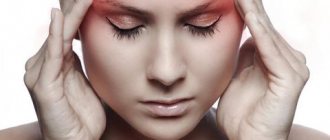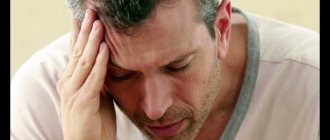Each of us has faced the problem of headaches and more than once was able to appreciate all the troubles of either short-term or long-term, debilitating cephalgia.
Our body reacts to the presence of a particular disease, so you shouldn’t just wait for the headache to go away on its own. It is necessary to understand its types, causes and choose the appropriate medicine, especially in cases where the headache lasts for several days, causing great discomfort and, of course, affecting the quality of life.
Types of cephalalgia
There are several main types of cephalgia.
Each of them has its own characteristics in manifestation and treatment tactics.
Vascular cephalgia
Occurs against the background of an increase or decrease in blood pressure. It is commonly believed that headaches appear only with hypertension, but in fact, headaches occur not only with severe vasodilation, but also with hypotension.
Possible diseases:
- hypertension;
- hypotension;
- atherosclerosis;
- migraine;
- cervical osteochondrosis;
- temporal arteritis.
Neuralgic cephalgia
Occurs with diseases of the trigeminal or occipital nerve at the site of their passage.
Most often - in the maxillofacial area.
Possible diseases:
- occipital neuralgia;
- trigeminal neuralgia.
Prevention
You can prevent prolonged migraines by tracking triggers - symptoms that irritate the trigeminal nerve. Avoid bright light, overwork, strong odors. Be sure to add physical activity: the neck muscles spasm when mobility in the chest disappears. Sometimes, to prevent pain while working at the computer, it is enough to stand up and load the gluteal muscles: swing your legs back. Dehydration, as one of the causes of vasospasm, can be eliminated by following a drinking regime.
The most common diseases causing cephalalgia
Despite the abundance of causes of headaches, I would like to dwell in more detail on 3 of them. These are migraines, poisoning and muscle tension.
Migraine
Migraines are equally likely to occur in children, adults, and adolescents. The average duration of attacks is from several hours to a week.
If we describe the sensations experienced by patients during a migraine, we can say that not only the head hurts, but there is a characteristic sharp pain in the area of the eye sockets, and there are also shootings towards the ear, jaw or back of the head.
Photophobia, nausea and lacrimation may occur. The causes of migraines are not known for certain; there are only unproven theories. The only thing that can be said with certainty is that women suffer from this disease much more often.
Tension headaches
They occur primarily against the background of stress, poor diet and drinking habits, lack of sleep, and prolonged exposure to an uncomfortable position. This type of pain is characterized by intense unpleasant sensations in the forehead area, radiating into the head.
Such headaches are often chronic and are accompanied by constant fatigue, poor sleep, and loss of appetite. They can last for several hours over 15-30 days.
Poisoning
In case of food or alcohol poisoning, headaches may appear, but they can hardly be called long-lasting. You can be poisoned not only by food or drinks, but also by medications. In this regard, patients are constantly warned that uncontrolled use of medications will not only not help in the current situation, but can also lead to poisoning.
Such cases are quite common, and the duration of the disease directly depends on the time it takes to remove drugs or alcohol from the body.
Recommendations for reducing pain symptoms
Each of the above types of cephalgia is accompanied by very unpleasant symptoms. Dizziness, nausea, photophobia are possible, the patient may complain that his head hurts for several days in a row, without stopping. In this case, there are ways to manage pain at home before visiting a medical facility. Namely:
- drink tea with lemon balm, lemon or mint;
- ventilate the room well;
- take a walk in the fresh air;
- do self-massage, best of all the temporal and occipital areas of the head;
- Take a contrast shower from time to time.
Preventive measures
The primary preventive measure has always been a healthy lifestyle. It is not uncommon for a long-term headache to subside simply after normalizing sleep and rest patterns. If you have a headache for a long time, sometimes a walk in the fresh air is enough. But when you are literally tormented by a persistent headache for several days in a row, and you don’t know what it could be, then you urgently need to see a doctor.
If you consume a lot of coffee, chocolate, smoked foods, alcohol and food with harmful additives, then later you don’t have to wonder why your head hurts for a long time.
It is also necessary, if possible, to combine physical and intellectual activity, work out longer in the gym, and, if possible, balance your work schedule to avoid overexertion. It often happens that a headache lasts for 5 days or even a month, but the patient tries to cope with it by uncontrolled taking pills. In this case, a person not only loses the time necessary for treatment, but can also cause irreparable harm to health.
Healthy lifestyle
The main prevention of any type of headache is maintaining a healthy lifestyle. Movement, moderate and feasible physical activity, healthy food, oxygen saturation - all this together brings good “fruits” for the body, strengthens the immune system, prevents many diseases, improves the quality of life and significantly prolongs it. But sedentary work, computers, televisions, fast food are the harmful factors that lead to many problems, including long-term and intense headaches.
And if a headache has already begun and continues for more than 2 days in a row, you should not delay - you need to go to the doctor, undergo a diagnostic examination and eliminate the identified problems. The sooner you start doing this, the faster and more effective the healing process will be. With timely identification of the problematic factor that causes long-term headaches, its elimination in most cases ends positively.
Headache in women
Separately, I would like to highlight the topic of female cephalgia. This can easily be explained by changes in hormonal levels, which is the cause of frequent headaches and mood swings. Headaches for several days in a row can bother the fair sex during the period:
- the beginning of menstruation;
- early pregnancy;
- menopause.
In all these cases, the headache is not due to the presence of any pathologies, but due to changes in hormonal levels. Mild headaches can be relieved with a cold compress or prolonged rest. Particular attention should be paid if a pregnant woman has a headache that does not go away for some time.
The seriousness of the situation is that most painkillers should not be taken during pregnancy. If symptoms appear, for example, due to poor nutrition or lack of sufficient air in the room, then it will be easy to cope with them.
But if a headache bothers you for two days or more, you shouldn't wait until it goes away on its own. You need to urgently contact your doctor.
How to eliminate pain
What to do for severe and prolonged headaches? First of all, if unpleasant symptoms appear, you should definitely consult a doctor, he will prescribe an examination, which includes:
- blood sugar test;
- MRI and CT examination of cerebral vessels;
- X-ray of the cervical spine;
- Doppler ultrasound (mainly prescribed to women during pregnancy);
- hormone tests.
A consultation with a neurologist is also required, who can identify possible disorders of the nervous system.
To relieve attacks, analgesics, non-steroidal anti-inflammatory drugs and antispasmodics are often used. The dosage and duration of medication is prescribed by a specialist individually for each patient.
With prolonged coughing, the patient develops a headache as a side effect; in this case, taking antitussive drugs is indicated.
If the headache is caused by nervous disorders, then I use antidepressants and sedatives for therapy. If a tumor is detected in the brain, it is removed and histological examination is performed. If malignancy is confirmed, a course of chemotherapy or radiation therapy is carried out.
General recommendations
At the first signs of cephalalgia, cool compresses on the forehead and complete rest will help get rid of the pain. The pain often goes away on its own (unless it is caused by serious disorders). If the cause of the attack was a jump in blood pressure, then you need to take a drug to stabilize it.
To saturate the brain with oxygen, it is recommended to ventilate the room in which the patient is located, or take a short walk in the fresh air. If after this the pain does not go away, then you need to take a non-steroidal anti-inflammatory drug or antispasmodic.
As first aid, you can do a light head massage, stretch your neck a little, and drink sweet herbal tea to help you relax.
During a severe headache, it is strictly forbidden to drink alcohol or perform physical work associated with serious stress. When working at a computer for a long time, you should not tilt your head too much towards the keyboard and it is recommended to warm up a little from time to time (walk around the office, squat, etc.).
Often, in addition to drug therapy, doctors prescribe a set of physiotherapeutic procedures. It includes therapeutic massage, a visit to a chiropractor (used in complex therapy, the doctor acts on certain areas of the body, resulting in a pain attack being relieved), acupuncture (improvement is observed after several sessions), exercise therapy, etc.
Ultrasound treatment, magnetic and heat therapy will be useful. For diseases of the cerebral vessels, the patient undergoes extracorporeal hemocorrection. Thanks to this procedure, cholesterol plaques are cleared and the risk of thrombosis is reduced.
Also, thanks to this technique, autoantibodies are removed from the blood, which cause multiple sclerosis and other disorders in the functioning of the immune system. The type of procedure depends on the disease that causes long-term, daily headaches.
Diet correction
If the pills do not help get rid of painful attacks, you need to adjust your diet. The following products are prohibited:
- smoked products and cheese, which contain the amino acid tyramine, which is the cause of headaches;
- chocolate and products containing it. They contain phenylethylamine, which causes attacks of pain; Chinese spices and products;
- all types of sausages, in the production of which nitrites are often used; nuts;
- alcoholic drinks;
- sweets, carbonated drinks and other products that contain aspartame.
It is best to eat fresh vegetables and fruits, which are rich in vitamins and microelements. You should consult a nutritionist about the correct selection of diet.
Today, treatment of migraines with Botox injections is very popular. The substance is injected into the area of the spasmed muscle, this allows you to relieve an attack of pain and has a relaxing effect.
Many patients claim that nothing helps them except traditional medicines. This is a rather controversial issue.
Among the methods of alternative medicine are:
- aromatherapy (the use of essential oil vapors to relieve headaches);
- warm baths with lavender, eucalyptus and sea salt;
- infusions and decoctions of medicinal plants (chamomile, mint, etc.);
- herbal tea based on lemon balm, motherwort, valerian.
It is often enough to drink a glass of warm milk with honey and go to bed, and the next morning the pain will go away. A massage using lavender or mint essential oils gives a relaxing effect and will help get rid of unpleasant sensations.
Very often, patients use clay wraps, to which you can add a little menthol oil. Such a compress is placed on the painful area, and after a while the unpleasant symptoms disappear.
You should not get carried away with traditional medicine methods, as this can cause undesirable consequences, because the causes of headaches can be serious pathologies in the body that require professional help from a specialist.
Rejection of bad habits
It is strictly forbidden to do the following in case of prolonged headaches:
- drink alcoholic beverages. Ethyl alcohol provokes vasodilation and increases pain;
- smoke. The nicotine contained in cigarettes causes a spasm of the blood vessels of the brain and causes a new attack of pain;
- apply ice compresses (in case of hypertension, this can cause rupture of a vessel and lead to a stroke);
- use a repeat dose of the analgesic drug if there is no improvement the first time. In this case, you can provoke an overdose and the development of side effects.
Diagnosis of the disease
When contacting a medical institution, you must describe your complaints to the doctor in detail:
- focus attention on the very first, perhaps even minor, manifestations of pain;
- clarify what form the headache attacks have, constant or periodic (specify how long the attack lasts);
- name additional symptoms accompanying this attack;
- indicate in which areas of the head the pain is more pronounced;
- describe pain sensations.
You can also speed up the diagnostic process with your own ideas about why your headache hurts, since you, if not you, know the individual characteristics of your body better than anyone else. And it is very important to mention the presence or absence of traumatic brain injuries; this information can radically change the plan for further treatment.
After your conversation, the doctor will need to refer you for additional tests and examinations:
- MRI;
- checking the blood vessels of the brain and neck;
- general and biochemical blood test;
- electroencephalography;
- consultations with other specialists.
Treatment of headaches
If the pills do not help, the patient should be prescribed adequate treatment, and it does not matter whether the headache has been a week or just the second day. This may include various procedures and prescription of medications.
Non-drug treatments include:
- exercise therapy;
- physiotherapy;
- massage of the temples and neck-collar area;
- acupuncture;
- lotions and compresses.
Medications prescribed depending on the type of cephalgia include:
- antidepressants;
- muscle relaxants;
- anti-inflammatory drugs (non-steroidal).
There are many different methods of dealing with headaches, including folk remedies, but only a qualified specialist can correctly diagnose the disease, explain what to do, and prescribe the correct treatment.
Basic treatment methods
After undergoing an examination and collecting an anamnesis, the doctor will prescribe the necessary treatment. It is necessary to strictly adhere to the doctor's instructions. Treatment will last at least ten days. Consist of a set of measures that cannot be neglected at your discretion.
Complex of therapeutic measures:
- if the cervical spine is unstable, you will need to wear a collar every day, the timing of its wearing will be determined by the doctor;
- physical therapy, it is better if the exercises are performed several times a day;
- acupuncture;
- cranial osteopathy;
- massage;
- physical procedures;
- manual therapy;
- compresses, ointments applied two or three times a day.
The use of medications is mandatory: antidepressants, non-steroidal anti-inflammatory drugs, muscle relaxants. Taken orally or injected intramuscularly every day.
Additionally, you will need to follow a diet, eat right, avoid stress, get proper rest, and maintain a daily routine.
Interesting: Headache when moving: causes, prevention, treatment
After completing the course of treatment, you can use our tips on how to prevent or quickly relieve headaches.











